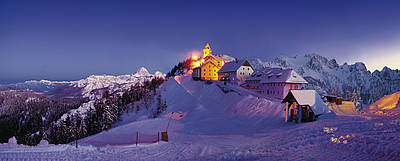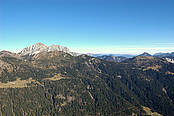Lussari
The Mount Santo di Lussari (which represents the symbol of spiritual union among the Alpine people), rises, south of Camporosso , at a height of 1789 metres above sea level, in a position looking over the whole Valcanale and Tarvisio basin. Immediately north-west of the peak at an altitude of 1766 , is the characteristic Sanctuary of the Virgin Mary, which dates back to the second half of the fourteenth century. According to legend, the Sanctuary (initially just a little more than a simple chapel) was built, by order of the Patriarch of Aquileia , on the mount where, in 1360 , a pleasant wooden statue of the Virgin Mary with Child was found among the bushes by a shepherd from Camporosso, and which is now worshiped on the high altar and is believed to be the original. To replace the primitive chapel, the present chancel was built, in the early 1500s, in stone, including the vault. The church with its bell tower and the two small side chapels, was found to date back to the first half of 1600 . It was consecrated in 1645 by the Bishop of Llubjiana. Since then Lussari has been the destination for numerous pilgrims and frequent pilgrimages over the centuries, mainly coming from Carinthia, Friuli, Carnia and even from Tyrol and Styria. Over the ages, various buildings offering shelter and refreshment have risen near the church, characteristically aligned along the small rocky ridge, but without any real architectural value. To celebrate the fourth centenary ( 1760 ) of the foundation, the festivities reached their height with three solemn pontificated days, celebrated by the prelates of Klagenfurt, Ossiach and Arnoldstein, with the help of twenty-four priests. The church, which was closed in 1786 by order of Emperor Joseph II , was left bare and silent (the Virgin Mary was taken to Camporosso) for a few years; by appeal of the same population of Camporosso and Tarvisio, the church was reopened to the worshipers following the decree of 15 September 1790 by Emperor Leopold II . It was struck down to a pile of rubble by a bolt of lightning in 1807 , but it was quickly rebuilt and extended. In 1860 it celebrated its fifth centenary, with a flow of about one hundred thousand pilgrims over the course of a year.
During the 1915-18 World War, the Sanctuary was used as an important observatory by the Austrian army and also for the artillery positioned nearby; it was burned and destroyed in the summer of 1916 by the medium calibre Italian artillery, who fired from Val Dogna (the Italian shooting line was directly from the Italian observatory located on Jof di Miezegnot at an altitude of 2087); while the big calibres fired from Dogna mainly at fort Hensel in Malborghetto. But, in the meantime, the small statue was again saved in Camporosso; then it was taken to Villach, Klagenfurt, Maribor and Dravograd. The Sanctuary and adjacent buildings were completely rebuilt in 1924 . The statue of the Virgin Mary was put back in its place on 24 June 1925 . Reconsecration took place on 1 June 1926 by the Archbishop of Gorizia. So multitudes of believers returned to climbing the steep slope of the Mount. Worthy of notice is the new wooden ceiling of the church, like a ship's hull , imitating, even though smaller, that of the Basilica of Aquileia. The wall paintings are by the Slovenian artist Tonj Kralj. During the Second World War , and exactly in 1943 , the church and houses were abandoned. Under the Nazi occupation, a few rare times, the bells of the Sanctuary were heard because of the initiative of tourists or alpinists who were passing through (as it happened on 15 August 1944, Assumption day, with the German garrison troops in the area consequently being put in a state of alarm). Only in 1948 the sacred image was finally placed in its secular location. But before it went up to the Mount again, and precisely on 20 May 1948 , to celebrate the day of fraternity, the statue was brought in a solemn procession to the borderline passage of Coccau, which at that time was still closed to free transit of civilians, and was placed on a portable altar on the line between the two barriers. The barriers were removed for hours; the valley people, who had been divided and were missing after the options made in 1939, after the sufferings of war, re-embraced each other under the eyes of the " Queen of Valcanale " (a second, recent solemn pilgrimage with the statue through the towns at the bottom of the valley took place in May 1998 ). In 1955 Giuseppe Nogara, Archbishop of Udine for nearly thirty years, coming to the end of his days, entrusted Monsignor Giuseppe Fontana, Deacon of Tarvisio, the "spirituality of Lussari" and the spreading of the cult of the Sanctuary. A few years later, in 1960 , the sixth centenary was solemnly celebrated, in the presence of Archbishop Giuseppe Zaffonato , over one hundred priests and clergymen of the Seminary and worshipers from everywhere. On that occasion the church was embellished with new paintings and windows in artistic glass. The flow of pilgrims and tourists was uninterrupted and so great that modernity knocked on the door of that sacred place asking to enter, without disturbing the new family atmosphere and live mysticism, that uncontested, gently stirs up there. Electrical power was introduced; internal and external lighting gave the Sanctuary, especially by night and from far, the aspect of an enchanted castle. Connected by the cableway , the Sanctuary was reachable to every type of person, to those who would never have dreamed of going up so high and of those who, due to their age, had long said their good-bye to the Virgin Mary of Lussari. Finally, the valuable aqueduct reached the Sanctuary.








